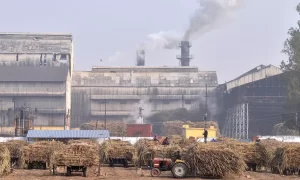Sugar mills float various options to beat a challenging 2023-24season

After many years, the Indian sugar sector is poised for multiple challenges in the new season, starting from October 1, primarily due to lower-than-expected production and rising demand from ethanol makers and domestic consumers.
The production in the 2023-24 sugar season, according to the current emerging consensus, is expected to be somewhere around 30-31 million tonnes after accounting for 4.5 million tonnes diverted towards ethanol, down from around 33 million tonnes in 2022-23.
However, this sugar production is good enough to meet the existing annual demand after the addition of an opening balance estimated to be around 28 million tonnes. But, the drop would also mean that after many years, the sugar industry is staring at a relatively tight demand and supply position.
The situation gets more complicated when the expected rise in mandated sugarcane price is added to the mix, mainly in states such as Uttar Pradesh, which is home to the largest number of private sugar millers in India. Any steep hike in sugarcane State Advised Price (SAP) in UP would increase the production cost of mills in this critical state. If the UP government avoids raising the price, it might face the wrath of farmers, something it can ill afford in an election year. To tide over various such challenges, there is chatter among the sugar industry players on different options to lessen the pain. Few discuss a staggered sugarcane FRP payment system to farmers, while others discuss a dual price mechanism.
Sources said that several such proposals could soon be under broached at a meeting of top government officials and sugar industry players on the sidelines of a Sugar Institute Event in Maharashtra.
So, what are these proposals being pursued in different quarters, and how feasible they are?
The first is the payment of sugarcane FRP in instalments, somewhat on the lines of what is being currently done in Gujarat.
Payment of Sugarcane FRP in installments So the Indian Sugar Mills Association (ISMA), the premier body of private sugar players in India, in a recent letter to the Commission for Agriculture Costs and Prices (CACP), batted for a staggered payment of sugarcane Fair and Remunerative Price (FRP) to farmers in instalments to lower the interest costs of sugar mills and also ensure that farmers get a higher price.
In the letter, the association said that sugar mills generally purchase or crush sugarcane for an average period of five to six months but sell sugar over the next 16-18 months.
Hence, they face difficulty in cane payment within 14 days due to revenue scarcity.
Therefore, mills are compelled to take loans from banks to make their cane payments, increasing costs.
The letter proposed that in the first place, 60 per cent of the FRP should be paid to the farmer within 14 days from the date of purchase of sugarcane, 20 per cent at the end of the crushing period in May or June and the balance 20 per cent after the season is over in October.
“This would mean that if 60 per cent payment is made at 11 per cent recovery, it would amount to around Rs 210.89 per quintal is paid as first instalment within 14 days. This would mean that not only the A2+FL cost is paid to farmers in the first instalment but roughly another Rs 29.89 a quintal is paid over and above the cost incurred (A2+FL cost of Rs 172 per quintal as per CACP report price policy report of 2023 2024 season is also paid to farmers,” the report said. Pointing at the pitfalls of the present system, where the full cane payment has to be made within 14 days, ISMA said that in the current system, while the first set of farmers gets 100 per cent payment, the latter ones get nil amount due to cash crunch. As the proposed 60 per cent FRP is paid as first instalment, the chances are that all the farmers will receive at least 60 per cent of the FRP within 14 days.
“Therefore, the instalment system would be fair and equitable to all farmers and at the same time 60 per cent FRP will completely cover their cost at A2+FL level, plus give a profit too,” the report said. The letter further said that the third instalment proposed to be made after the season is over is based on the reason that the total sugarcane price paid to the farmer in a season is determined based on the average sugar price in the 12 months as also the sugar recovery of the whole season (i.e. October 1 to September 30).
These variables can be determined only after the season is over. But, given that elections are round the corner and sugarcane price is a sensitive issue for farmers, it is very unlikely that such a bold proposal would clear the administrative muster. Dilip S Patil, an eminent sugar sector expert and managing director of Karmayogi Ankushrao Tope Samarth Sahakari Sakar Karkhana (Cooperative Sugar Factory) in Maharashtra, said that the state of Gujarat has already implemented an instalment policy for sugarcane farmers, which allows them to receive 80 per cent of the FRP amount at the time of delivery of sugarcane and the remaining 20 per cent after a period of six months since 2018 and has been well-received by farmers in the state.
“The payment of FRP in instalments could help sugar mills to manage their cash flow better. Ultimately, the goal should be to find a fair solution to both farmers and sugar mills,” Patil told Business Standard. Dual Sugar Pricing The second proposal that is being actively discussed in industry forums is the dual
pricing of sugar. This could mean that a different minimum sale price is fixed for sugar sold to commercial users that are soft-drink makers and confectionary units and another set of minimum prices for domestic retail users.
Traditionally, industry sources said out of the total annual domestic consumption of around 27-28 million tonnes of sugar, almost 60 per cent is from commercial users and bulk buyers, while the rest is from small retail household buyers. Let’s say the MSP for bulk buyers is raised to Rs 40 a kilogram ex-mill from the existing Rs 31 per kg while that for retail buyers is maintained at the current level. This could ensure a steady cash flow for the industry as the MSP is the benchmark rate on which banks lend to the sugar sector every year. There won’t be any unnecessary price burden on the average retail consumer, which is completely unacceptable in an election year for any government. However, some industry players said that implementing such an idea is difficult in the first place.
Also, it might go the monthly quota system, wherein the same sugar industry that pitched for its abolition was forced to demand a recall after supplies got out of control. “The demand for a dual-rate policy for sugar is a matter of critical concern for the sugar industry. Just as the previous demand for the withdrawal of the release mechanism for sugar was not grounded in the reality of the industry, leading to an oversupply and subsequent price decline, it will find itself faced with a similar situation,” Dlip S Patil of the Karmayogi Ankushrao Tope Samarth Sahakari Sakar Karkhana (Cooperative Sugar Factory) in Maharashtra said. He said the call for a dual-rate policy for sugar lacks a comprehensive consideration of future challenges and potential risks associated with its implementation.
It is imperative to recognize that such a policy could instigate market distortions and inefficiencies, and inadvertently incentivize illegal activities such as smuggling, hoarding, adulteration, and black marketing of sugar. Patil also discounted the almost 60 per cent of sugar being used for industrial purposes, saying that according to the International Sugar Organization (ISO), globally, only 15-20 per cent of sugar is used for this (industrial use), while Indian experts say about 60 per cent of sugar in India is used for industrial purposes.
Uppal Shah, Co-founder & CEO, AgriMandi.live Research has a balanced view on this. He said if the government feels that a dual pricing policy for sugar is essential, keeping in mind that sugar mills have liquidity issues as they have to make timely sugarcane price payments to farmers and provisions for other costs, then there is no harm in exploring the option. “However, the execution of dual pricing for sugar would require careful planning and execution as managing dual prices for a singular product would be an uphill task. There has to be proper SOP for this,” Shah said.














